West Indian manatee
The West Indian Manatee (Trichechus manatus) or "sea cow", also known as North American manatee, is the largest surviving member of the aquatic mammal order Sirenia (which also includes the dugong and the extinct Steller's sea cow). It is further divided into two subspecies, the Florida manatee (T. m. latirostris) and the Antillean or Caribbean manatee (T. m. manatus), based on genetic and morphological studies.[6][7] The Florida subspecies is primarily found along the coasts of Florida, but its range extends as far west as Texas and as far north as Massachusetts.[8] The Antillean subspecies has a sparse distribution throughout the Caribbean, ranging as far north as Mexico and as far south as Brazil.[9][10]
| West Indian Manatee[1] | |
|---|---|
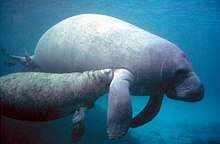 | |
| Adult with calf | |
| Scientific classification | |
| Kingdom: | Animalia |
| Phylum: | Chordata |
| Class: | Mammalia |
| Order: | Sirenia |
| Family: | Trichechidae |
| Genus: | Trichechus |
| Species: | T. manatus |
| Binomial name | |
| Trichechus manatus | |
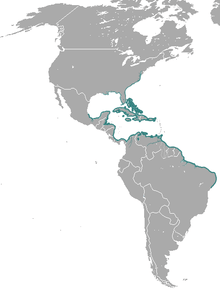 | |
| West Indian manatee range | |
Manatees are obligate herbivores, have developed vocal communication abilities, and are covered in highly sensitive vibrissae that are used for feeding and navigation.[11] In breeding season, several males form mating herds around an individual female; on average, one calf is born to a female manatee every two to three years.[12]
The West Indian manatee was listed as endangered under the Endangered Species Act in the 1970's, when there were only several hundred left,[13] and the decades since have witnessed significant efforts by federal, state, private, and nonprofit organizations to protect these species from natural and human-induced threats, particularly collisions with watercraft.[14] On March 30, 2017, the US Secretary of the Interior Ryan Zinke announced the federal reclassification of the West Indian manatee from endangered to threatened, citing a substantial increase in the total population.[13][15]
Description
The average West Indian manatee is about 2.7–3.5 m (8.9–11.5 ft) long and weighs 200–600 kg (440–1,320 lb), with females generally larger than males.[16] The largest individual on record weighed 1,655 kg (3,649 lb) and measured 4.6 m (15 ft) long.[17][18] Manatees are estimated to live 50 years or more in the wild,[12] and one captive Florida manatee, Snooty, lived for 69 years.[19]
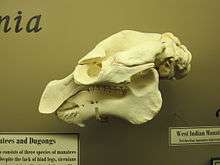
Since manatees are mammals, they breathe air, have warm blood, and produce milk. Like the other sirenians, the West Indian manatee has adapted fully to aquatic life, having no hind limbs. Instead of hind limbs, the manatee has a spatula-like paddle for propulsion in the water. Manatees have evolved streamlined bodies which lack external ear flaps, thus decreasing resistance in the aquatic environment. Pelage cover is sparsely distributed across the body, which may play a role in reducing the build-up of algae on their thick skin. Manatee skin is gray but can vary in coloration due to algae and other biota, like barnacles, that opportunistically live on manatees. Scar tissue on manatees is white and persists for decades, allowing for easy identification. The Florida manatee has three to four nails on each flipper.[20]
The West Indian manatee has a prehensile snout, like their relative the elephant, for grabbing vegetation and bringing it into their mouths. Manatees have six to eight moliform teeth in each jaw quadrant. These moliform teeth are generated at the back of the mouth and slowly migrate towards the front of the mouth, at a rate of 1–2 mm per month, where they then fall out. This tooth ‘conveyor belt’ provides unlimited tooth production which is beneficial for the manatee which feeds on vegetation four to eight hours per day and consumes 5-10% of its body weight per day. Manatees have 3–5 cm hairs that cover their whole body and provide somatosensory information. Manatee bones are dense and solid which allows them to act as ballast and promote negative buoyancy. This helps counteract the positive buoyancy which comes from their high fat content. These two buoyancy counterparts, along with air in the lungs, helps manatees achieve neutral buoyancy in the water. This makes breathing, foraging, and swimming easier for the manatee. Manatees are unique, compared to other mammals, in that they have a longitudinally oriented diaphragm that is spit in half to form two hemidiaphragms. Each hemidiaphragm is capable of independent muscular contractions.[20]
Distribution and habitat
The West Indian manatee inhabits mostly shallow coastal areas, including rivers and estuaries. Manatees can withstand large changes in salinity and have been found in highly brackish and saline waters.[12] Manatees' extremely low metabolic rate and lack of a thick layer of insulating body fat limits them to locations with warm waters, including tropical regions. Although most commonly found along the Florida coast, the West Indian manatee has been spotted as far north as Dennis, Massachusetts, and as far west as Texas.[8] A manatee was spotted in the Wolf River (near where it enters the Mississippi) in Memphis, Tennessee in 2006.[21] An analysis of mitochondrial DNA patterns indicates there are actually three primary geographic groups of the West Indian manatee: (1) Florida and the Greater Antilles; (2) Mexico, Central America and northern South America; and (3) northeastern South America.[22][23]
The seasonal distribution of the West Indian manatee varies with water temperatures. Temperatures below approximately 20 °C (68 °F) increase the risk of cold-induced stress or mortality for manatees.[12][24] Consequently, Florida manatees seek out warm-water refuges during the winter, concentrated primarily along the Florida peninsula.[25] Many of these refuges are artificial, created by the runoff from nearby power plants.[26] In contrast, the Antillean manatee is less susceptible to cold-induced stress due to the warmer waters across its range.
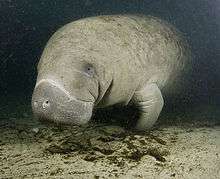
Florida manatees inhabit the most northern limit of sirenian habitats. There are four recognized subpopulations of the Florida manatee, termed the Northwest, Southwest, Atlantic Coast, and St. John's River populations.[27] Large concentrations of Florida manatees are located in the Crystal River[28] and Blue Springs regions in central and north Florida. The Antillean manatee is sparsely distributed throughout the Caribbean and the northwestern Atlantic Ocean, from Mexico, east to the Greater Antilles, and south to Brazil. Populations can also be found in The Bahamas, French Guiana, Suriname, Guyana, Trinidad, Venezuela, Colombia, Panama, Costa Rica, Nicaragua, Honduras, Guatemala, Belize, Cuba, Haiti, the Dominican Republic, Jamaica, and Puerto Rico.[15]
Behavior and diet
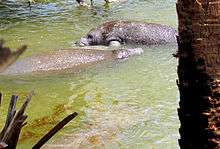
Behavior
Because manatees evolved in habitats without natural predators, they lack predator avoidance behavior. The large size and low metabolic rates of manatees lends to their capacity for long and deep dives, as well as their relative lack of speed. Manatees are frequently solitary creatures, but they do aggregate at warm-water habitats during the winter and during the formation of breeding herds.[12]
Communication
Manatees have been shown to form large mating herds when males come across estrous females, indicating that males may be able to sense estrogen or other chemical indicators.[29][30] Manatees can communicate information to each other through their vocalization patterns.[31] Sex and age-related differences are apparent in the vocalization structure of common squeaks and screeches in adult males, adult females, and juveniles.[32][33] This may be an indication of vocal individuality among manatees.[33] An increase in manatee vocalization after a vocal playback stimulus shows that they may be able to recognize another manatee's individual voice.[33] This behavior in manatees is found mostly between mother and calf interactions.[34] However, vocalization can still be commonly found in a variety of social interactions within groups of manatees, which is similar to other aquatic mammals.[34][35] When communicating in noisy environments, manatees that are in groups experience the same Lombard effect as humans do; where they will involuntary increase their vocal effort when communicating in loud environments.[36] Based on acoustic and anatomical evidence, mammalian vocal folds are assumed to be the mechanism for sound production in manatees.[37] Manatees also eat other manatees' feces; it is assumed that they do this to gather information about reproductive status or dominance, indicating the important role chemoreception plays in the social and reproductive behavior of manatees.[29]
Diet
Manatees are obligate herbivores that feed on over 60 species of aquatic plants in both fresh and salt water. Seagrass is a staple of the manatee diet, particularly in coastal areas.[38] In addition, when the tide is high enough, they will also feed on grasses and leaves.[39] Manatees typically graze for five or more hours per day, consuming anywhere from 4% to 10% of their body weight in wet vegetation per day, though the exact amount depends on their body size and activity level.[40] Because manatees feed on abrasive plants, their molars are often worn down and are replaced many times throughout their lives, thus earning the nickname "marching molars." The molar teeth are similar in shape, but of varying sizes. Manatees do not have incisors; these have been replaced by horny gingival plates.[41]
Manatees are nonruminants with an enlarged hindgut. Unlike other hindgut fermenters, such as the horse, manatees efficiently extract nutrients, particularly cellulose, from the aquatic plants in their diet. Manatees have a large gastrointestinal tract with contents measuring about 23% of its total body mass. In addition, the passage rate of food is very long (about seven days).[42] This slow process increases the digestibility of their diet. It is suggested that chronic fermentation may also provide additional heat and is correlated with their low metabolic rate.[39]
Vibrissae

Manatees have sensitive tactile hairs that cover their bodies and faces called vibrissae. Each individual hair is a vibrissal apparatus called a follicle-sinus complex. Vibrissae are blood filled sinuses bound by a dense connective tissue capsule with sensitive nerve endings that provides haptic feedback to the manatee.[11]
Usually vibrissae are found on the facial regions of terrestrial and non-sirenian aquatic animals and are called whiskers. Manatees, however, have vibrissae all over their bodies. The vibrissae located in their facial region are roughly 30 times denser than the vibrissae on the rest of their body. Their mouth consists of very mobile prehensile lips which are used for grasping food and objects. The vibrissae on these lips are turned outward during grasping and are used in locating vegetation. Their oral disks also contain vibrissae which have been classified as bristle-like hairs that are used in nongrasping investigation of objects and food.[43][44]
Manatee vibrissae are so sensitive that they are able to perform active touch discrimination of textures. Manatees also use their vibrissae to navigate the turbid waterways of their environment. Research has indicated that they are able to use these vibrissae to detect hydrodynamic stimuli in the same way that fish use their lateral line system.[11]
Reproduction
Male manatees reach sexual maturity at 3–4 years of age, while females reach sexual maturity at 3–5 years of age.[45][12] Manatees appear capable of breeding throughout their entire adult life, although most females first breed successfully at ages 7–9. Breeding occurs in ephemeral mating herds, where several males aggregate around an estrous female and compete for access to her.[46] Larger males, presumably older, have been observed to dominate mating herds and are likely responsible for most successful copulation events.[47]
The gestation period in manatees lasts for 12–14 months, after which they give birth to one calf at a time, or rarely twins.[47] When a calf is born, it usually weighs 60–70 lb (27–32 kg) and is 4.0–4.5 ft (1.2–1.4 m) long. Manatees do not form permanent pair bonds and the male contributes no parental care to the calf, which remains with the mother for up to two years prior to weaning. A single female can reproduce once every 2–3 years.[12] Wild manatees have been documented producing offspring into their late 30's, and a female captive manatee has given birth in her 40's.[48]
Threats and conservation
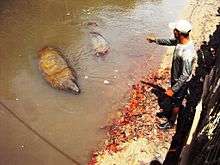
The West Indian manatee has been included on the US Endangered Species List since the 1970's. In October 2007, the International Union for the Conservation of Nature (IUCN) assessed the West Indian manatee as vulnerable, and both the Florida and Antillean subspecies as endangered.[49] The full species and both subspecies qualified for their respective classifications due to a combination of a low number of mature individuals, and a significant projected decline in total population numbers over the next two generations (about 20 years per generation in manatees).
Threats to the Florida and Antillean subspecies are relatively separate, though sometimes overlapping. The greatest causes of Florida manatee deaths include collisions with watercraft, high perinatal mortality, the loss of warm-water habitat, and red tide.[50][51] Antillean manatees face severe habitat fragmentation,[52] as well as continued pressure from illegal hunting.[53]
The 2017 decision to reclassify the West Indian manatee from endangered to threatened under the Endangered Species Act cited increases in the populations of both subspecies.[15] The decision was not without controversy, however: according to Save the Manatee Club, the US Fish and Wildlife Service failed to adequately consider data from 2010 to 2016, during which time manatees suffered from unprecedented mortality events linked to habitat pollution, dependence on artificial warm water sources, and record deaths from watercraft strikes.[54] The official notice of the reclassification made clear that, even with the downlisting, all federal protections for the West Indian manatee under the Endangered Species Act would remain in place.[13] The West Indian manatee is also protected by the Florida Manatee Sanctuary Act of 1978 and the US Marine Mammal Protection Act of 1972.
T. m. latirostris (Florida manatee)
A 1997 population viability analysis of the Florida manatee projected a 44% chance of extinction within the next 1,000 years without improvements in habitat conditions and new protective regulations.[55] Since then, prospects for the subspecies have improved. In 2016, the US Geological Survey collaborated with the Florida Fish and Wildlife Service to re-evaluate the status of the Florida manatee under the Core Biological Model, which is used to estimate population viability. This assessment analyzed total population on the east and west coasts of Florida and estimated that the likelihood of either population falling under 500 adults within 100 years was about 0.42%.[56] The projected improvement of population numbers and stability is contingent on continued intervention and monitoring efforts.
At least 35% of Florida manatee deaths are estimated to result from watercraft collisions.[57] Manatees respond to approaching vessels by orienting towards deeper waters and increasing their speed,[58] but they are nevertheless frequently struck due to their large size and sluggishness.[59] Aerial surveys of Florida manatee and boat distribution have been conducted to map the areas in which collisions are most likely to occur, accounting for environmental and seasonal factors.[60] Watercraft can frequently avoid hitting manatees simply by reducing speed, allowing time for the manatee to escape out of range.[61] Despite improvements in modeling and changes to local regulations, a 2017 report found that 104 manatees were killed by collisions with watercraft in the previous year, one of the highest totals on record.[62]
Projected long-term loss of warm-water habitats presents a significant risk to manatees, who are unable to tolerate temperatures lower than 20 °C (68 °F).[63][20] Florida manatees frequently congregate around the warm discharge given off by power plants throughout the winter months; however, as older plants are replaced with more energy-efficient structures, manatees could become at risk of cold-induced death due to reduced availability of warm-water refuges.[64] Manatees can recall previous refuge sites and frequently return to them in successive winters, but some conservationists fear that manatees may become overly reliant on warm-water locations generated by power plants that may shut down soon.[65][66] In areas where manatees lack access to power plants or natural warm springs, they instead seek out natural deep water zones that passively remain above tolerable temperatures.[67]
Red tide is a common name for algal blooms, deriving its distinctive color from pigmentation molecules in the algae. The blooms produce brevetoxins which are potentially fatal to marine life. Most manatee deaths from red tide occur when manatees ingest the red tide alongside seagrass, their primary food source.[68] Red tide blooms and related manatee mortality tend to co-occur during the spring.
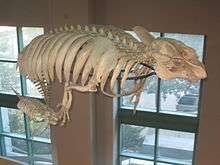
T. m. manatus (Antillean manatee)
There is relatively little data on the Antillean manatee compared to its Florida counterpart. Phylogenetic studies on the Antillean manatee have revealed low genetic diversity among its populations, likely due to limitations on dispersal.[69][70] Captive breeding, as well as the rehabilitation of manatee calves discovered without their mothers nearby, can supplement local conservation strategies, but populations are nevertheless at risk of inbreeding depression and local extinction.[71][72]
Whereas the population trends of the Florida manatee are relatively well monitored, population data for the Antillean manatee is sparse due to its patchy distribution, as well as the relative turbidity and low levels of light in its habitat which can mitigate the effectiveness of aerial or sonar-based surveys, often resulting in inaccurate or erroneous measurements.[73][74] A 2016 study on the Antillean manatee population of Brazil found a potential range for current population size between 485 and 2,221 individuals.[75] The US Fish and Wildlife Service estimated in 2017 that as many as 6,782 individuals might exist in the Antillean subspecies, but these results rely in large part on personal anecdotes and may overestimate the true population number.[15] A 2012 study of the Antillean population documented significant human-related causes of mortality, and projected that if the share of human-caused manatee deaths per year rose to 5% or more, the population would face a severe decline and eventual extinction.[52]
References
- Shoshani, J. (2005). "Order Sirenia". In Wilson, D.E.; Reeder, D.M (eds.). Mammal Species of the World: A Taxonomic and Geographic Reference (3rd ed.). Johns Hopkins University Press. p. 93. ISBN 978-0-8018-8221-0. OCLC 62265494.
- "Trichechus manatus Linnaeus 1758 (manatee)". PBDB.
- "Collared peccary (Mammalia, Artiodactyla, Tayassuidae, Pecari) from the late Pleistocene of Florida". 2009-01-01. Cite journal requires
|journal=(help) - Deutsch, C.J.; Self-Sullivan, C. & Mignucci-Giannoni, A. (2008). "Trichechus manatus". IUCN Red List of Threatened Species. 2008: e.T22103A9356917. doi:10.2305/IUCN.UK.2008.RLTS.T22103A9356917.en.
- Linnæus, Carl (1758). Systema naturæ per regna tria naturæ, secundum classes, ordines, genera, species, cum characteribus, differentiis, synonymis, locis. Tomus I (in Latin) (10th ed.). Holmiæ: Laurentius Salvius. p. 34. Archived from the original on 8 November 2012. Retrieved 22 November 2012.
- Domning, Daryl P.; Hayek, Lee-Ann C. (1986). "Interspecific and intraspecific morphological variation in manatees (Sirenia: Trichechus)". Marine Mammal Science. 2 (2): 87–144. doi:10.1111/j.1748-7692.1986.tb00034.x.
- Hatt, Robert T. (1934). "The American Museum Congo Expedition manatee and other recent manatees". Bulletin of the American Museum of Natural History. 66: 533–566.
- Manatees Archived 2012-05-08 at the Wayback Machine, Buzzards Bay National Estuary Program
- Morales-Vela, Benjamı́n; Olivera-Gómez, David; Reynolds III, John E.; Rathbun, Galen B. (2000-08-01). "Distribution and habitat use by manatees (Trichechus manatus manatus) in Belize and Chetumal Bay, Mexico". Biological Conservation. 95 (1): 67–75. doi:10.1016/S0006-3207(00)00009-4. ISSN 0006-3207.
- Vianna, Juliana A.; Bonde, Robert K.; Caballero, Susana; Giraldo, Juan Pablo; Lima, Régis P.; Clark, Annmarie; Marmontel, Míriam; Morales‐Vela, Benjamín; Souza, Maria José De; Parr, Leslee; Rodríguez‐Lopez, Marta A. (2006). "Phylogeography, phylogeny and hybridization in trichechid sirenians: implications for manatee conservation". Molecular Ecology. 15 (2): 433–447. doi:10.1111/j.1365-294X.2005.02771.x. ISSN 1365-294X. PMID 16448411.
- Gaspard, JC; Bauer, GB; Reep, RL; Dziuk, K; Read, L; Mann, DA (2013). "Detection of Hydrodynamic Stimuli by the Florida Manatee (Trichechus manatus latirostris)". Journal of Comparative Physiology. 199 (6): 441–50. doi:10.1007/s00359-013-0822-x. PMID 23660811.
- "South Florida Multi-Species Recovery Plan".
- Daley, Jason (April 3, 2017), "Manatees Move From Endangered to Threatened: But conservationists say the species still faces significant threats", Smithsonian, retrieved April 4, 2017
- Martin, Julien; Sabatier, Quentin; Gowan, Timothy A.; Giraud, Christophe; Gurarie, Eliezer; Calleson, Charles Scott; Ortega‐Ortiz, Joel G.; Deutsch, Charles J.; Rycyk, Athena; Koslovsky, Stacie M. (2016). "A quantitative framework for investigating risk of deadly collisions between marine wildlife and boats". Methods in Ecology and Evolution. 7 (1): 42–50. doi:10.1111/2041-210X.12447. ISSN 2041-210X.
- "Manatee Reclassified from Endangered to Threatened as Habitat Improves and Population Expands". fws.gov (Press release). Fish & Wildlife Service, US Department of the Interior. March 30, 2017. Archived from the original on April 7, 2017. Retrieved April 4, 2017.
- Trichechus manatus Archived 2011-09-04 at the Wayback Machine, Animal Diversity Web
- Wood, G.L. (1983). The Guinness Book of Animal Facts and Feats. 3rd revised edition. Sterling Pub Co Inc., ISBN 978-0851122359
- Manatees Archived 2012-01-18 at the Wayback Machine, Busch Gardens
- "Snooty, world's oldest known manatee, dies one day after celebrating birthday". Fox News. 2017-07-23. Archived from the original on 2017-07-23. Retrieved 2017-07-23.
- Reep, R. L. & Bonde, R. K. (2006). The Florida manatee: Biology and conservation. Gainesville: The University Press of Florida.
- "Manatee found dead in Tenn. lake". Associated Press. 11 December 2006. Archived from the original on 24 September 2016. Retrieved 24 June 2017.
- Garcia-Rodriguez, A. I.; Bowen, B. W.; Domning, D; Mignucci-Giannoni, A; Marmontel, M; Montoya-Ospina, A; Morales-Vela, B; Rudin, M; Bonde, R. K.; McGuire, P. M. (1998). "Phylogeography of the West Indian manatee (Trichechusmanatus): How many populations and how many taxa?". Molecular Ecology. 7 (9): 1137–1149. doi:10.1046/j.1365-294x.1998.00430.x. PMID 9734072.
- Vianna, J. A.; Bonde, R. K.; Caballero, S; Giraldo, J. P.; Lima, R. P.; Clark, A; Marmontel, M; Morales-Vela, B; De Souza, M. J.; Parr, L; Rodríguez-Lopez, M. A.; Mignucci-Giannoni, A. A.; Powell, J. A.; Santos, F. R. (2006). "Phylogeography, phylogeny and hybridization in trichechid sirenians: implications for manatee conservation". Molecular Ecology. 15 (2): 433–47. doi:10.1111/j.1365-294X.2005.02771.x. PMID 16448411.
- Haubold, E.; et al. (April 2006). Final Biological Status Review of the Florida Manatee (Trichechus manatus latirostris)] (PDF) (Report). Assessment 2005–2006. Florida Manatee Biological Review Panel. p. 133. Retrieved April 5, 2017.
- Deutsch, Charles J.; Reid, James P.; Bonde, Robert K.; Easton, Dean E.; Kochman, Howard I.; O'Shea, Thomas J. (2003). "Seasonal Movements, Migratory Behavior, and Site Fidelity of West Indian Manatees along the Atlantic Coast of the United States". Wildlife Monographs (151): 1–77. ISSN 0084-0173. JSTOR 3830830.
- IUCN (2008-06-30). "Trichechus manatus: Deutsch, C.J., Self-Sullivan, C. & Mignucci-Giannoni, A.: The IUCN Red List of Threatened Species 2008: e.T22103A9356917". IUCN Red List of Threatened Species. 2008-06-30. doi:10.2305/iucn.uk.2008.rlts.t22103a9356917.en.
- Laist, David W.; Taylor, Cynthia; Iii, John E. Reynolds (2013-03-20). "Winter Habitat Preferences for Florida Manatees and Vulnerability to Cold". PLOS One. 8 (3): e58978. Bibcode:2013PLoSO...858978L. doi:10.1371/journal.pone.0058978. ISSN 1932-6203. PMC 3604035. PMID 23527063.
- "About the Manatees | Crystal River, Florida | Bird's Underwater". Birds Underwater. Archived from the original on 2017-10-07. Retrieved 2017-10-06.
- Bauer, G. B.; Colbert, J. C. Gaspard III (2010). "Learning About Manatees: A Collaborative Program between New College of Florida and Mote Marine Laboratory to Conduct Laboratory Research for Manatee Conservation". International Journal of Comparative Psychology. 23: 811–825. Archived from the original on 2018-05-14.
- Reynolds, J. E., III; Odell, D. K. (1991). Manatees and Dugongs. New York: Facts on File, Inc.
- Sousa-Lima, Renata S.; Paglia, Adriano P.; Fonseca, Gustavo A. B. (2002). "Signature information and individual recognition in the isolation calls of Amazonian manatees, Trichechus inunguis (Mammalia: Sirenia)". Animal Behaviour. 63 (2): 301–310. doi:10.1006/anbe.2001.1873.
- Sousa-Lima, Renata S.; Paglia, Adriano P.; Fonseca, Gustavo A. B. (2008). "Gender, Age, and Identity in the Isolation Calls of Antillean Manatees (Trichechus manatus manatus)". Aquatic Mammals. 34 (1): 109–122. doi:10.1578/AM.34.1.2008.109.
- Umeed, Rebecca; Attademo, Loffler N.; Bezerra, Bruna (2018). "The influence of age and sex on the vocal repertoire of the Antillean manatee (Trichechus manatus manatus) and their response to call playback". Marine Mammal Science. 34 (3): 577–594. doi:10.1111/mms.12467.
- Reynolds, John E. II (1981). "Aspects of the social behavior and herd structure of a semi-isolated colony of West Indian manatees, Trichechus manatus". Mammalia. 45 (4): 431–451. doi:10.1515/mamm.1981.45.4.431.
- Herzing, Denise L. (1996). "Vocalization and associated underwater behavior of free-ranging Atlantic spotted dolphins, Stenella frontalis and bottlenose dolphins, Tursiops truncates". Aquatic Mammals. 22 (2): 61–79. doi:10.12966/abc.02.02.2015.
- Mikisis-Olds, Jennifer L.; Tyack, Peter L. (2008). "Manatee (Trichechus manatus) vocalization usage in relation to environmental noise levels". Acoustical Society of America. 125 (3): 1806–1815. doi:10.1121/1.3068455. hdl:1912/2740. PMID 19275337.
- Landrau‐giovannetti, Nelmarie; Mignucci‐giannoni, Antonio A.; Reidenberg, Joy S. (2014). "Acoustical and Anatomical Determination of Sound Production and Transmission in West Indian (Trichechus manatus) and Amazonian(T. inunguis) Manatees". The Anatomical Record. 297 (10): 1896–1907. doi:10.1002/ar.22993. PMID 25044536.
- Lefebvre, Lynn W.; Reid, James P.; Kenworthy, W. Judson; Powell, James A. (1999). "Characterizing Manatee habitat use and seagrass grazing in Florida and Puerto Rico: implications for conservation and management". Pacific Conservation Biology. 5 (4): 289–298. doi:10.1071/pc000289. ISSN 2204-4604.
- Best, Robin C. (1981-03-01). "Foods and feeding habits of wild and captive Sirenia". Mammal Review. 11 (1): 3–29. doi:10.1111/j.1365-2907.1981.tb00243.x. ISSN 1365-2907.
- Allen, Aarin (2015). "Using the West Indian Manatee (Trichechus manatus) as a Mechanism for Invasive Aquatic Plant Management in Florida". Journal of Aquatic Plant Management. 53: 95–104. Archived from the original on 2017-09-02.
- CRC handbook of marine mammal medicine. Dierauf, Leslie A., 1948-, Gulland, Frances M. D. (2nd ed.). Boca Raton, FL: CRC Press. 2001. ISBN 9780849308390. OCLC 45888920.CS1 maint: others (link)
- Reynolds, John E.; Rommel, Sentiel A. (1996-07-01). "Structure and function of the gastrointestinal tract of the Florida manatee, Trichechus manatus latirostris". The Anatomical Record. 245 (3): 539–558. doi:10.1002/(sici)1097-0185(199607)245:3<539::aid-ar11>3.0.co;2-q. ISSN 1097-0185. PMID 8800413.
- Hartman DS. (1979). Ecology and behavior of the manatee (Trichechus manatus) in Florida. American Society of Mammalogists Special Publication No. 5. 1–153.
- Marshall, CD; Huth, GD; Edmonds, VM; Halin, DL; Reep, RL (1998). "Prehensile use of perioral bristles during feeding and associated behaviors of the Florida manatee (Trichechus manatus latirostris)". Marine Mammal Science. 14 (2): 274–289. doi:10.1111/j.1748-7692.1998.tb00716.x.
- Rommel, Sentiel A. (2001). "Functional morphology of venous structures associated with the male and female reproductive systems in Florida manatees (Trichechus manatus latirostris)". The Anatomical Record. 264 (4): 339–47. doi:10.1002/ar.10022. PMID 11745089.
- Hartman, Daniel Stanwood; Mammalogists, American Society of (1979). Ecology and behavior of the Manatee (Trichechus manatus) in Florida /. [Pittsburgh, Pa.]: American Society of Mammalogists. doi:10.5962/bhl.title.39474.
- "Reproduction in free- ranging Florida manatees". National Biological Service Information and Technology Report 1.
- IUCN (2008-06-30). "Trichechus manatus: Deutsch, C.J., Self-Sullivan, C. & Mignucci-Giannoni, A.: The IUCN Red List of Threatened Species 2008: e.T22103A9356917". IUCN Red List of Threatened Species. 2008-06-30. doi:10.2305/iucn.uk.2008.rlts.t22103a9356917.en.
- IUCN (2008-06-30). "Trichechus manatus: Deutsch, C.J., Self-Sullivan, C. & Mignucci-Giannoni, A.: The IUCN Red List of Threatened Species 2008: e.T22103A9356917". IUCN Red List of Threatened Species. 2008-06-30. doi:10.2305/iucn.uk.2008.rlts.t22103a9356917.en.
- Halvorsen, K. M.; Keith, E. O. (2008). "Immunosuppression cascade in the Florida manatee (Trichechus manatus latirostris)". Aquatic Mammals. 34 (4): 412–419. doi:10.1578/AM.34.4.2008.412.
- Runge, Michael C.; Sanders-Reed, Carol A.; Langtimm, Catherine A.; Hostetler, Jeffrey A.; Martin, Julien; Deutsch, Charles J.; Ward-Geiger, Leslie I.; Mahon, Gary L. (2017). "Status and threats analysis for the Florida manatee (Trichechus manatus latirostris), 2016". Scientific Investigations Report. doi:10.3133/sir20175030.
- Castelblanco-Martínez, Dn; Nourisson, C; Quintana-Rizzo, E; Padilla-Saldivar, J; Schmitter-Soto, Jj (2012-08-16). "Potential effects of human pressure and habitat fragmentation on population viability of the Antillean manatee Trichechus manatus manatus: a predictive model". Endangered Species Research. 18 (2): 129–145. doi:10.3354/esr00439. ISSN 1863-5407.
- Olivera-Gómez, L. D; Mellink, E (2005-01-01). "Distribution of the Antillean manatee (Trichechus manatus manatus) as a function of habitat characteristics, in Bahı́a de Chetumal, Mexico". Biological Conservation. 121 (1): 127–133. doi:10.1016/j.biocon.2004.02.023. ISSN 0006-3207.
- "Highly Controversial Federal Action Puts Manatees in Harm's Way". savethemanatee.org (Press release). Save the Manatee Club. Archived from the original on 2017-06-06. Retrieved 2017-07-02.
- Marmontel, Miriam; Humphrey, Stephen R.; O'Shea, Thomas J. (1997). "Population Viability Analysis of the Florida Manatee (Trichechus manatus latirostris), 1976-1991". Conservation Biology. 11 (2): 467–481. doi:10.1046/j.1523-1739.1997.96019.x. ISSN 0888-8892. JSTOR 2387620.
- Runge, Michael C.; Sanders-Reed, Carol A.; Langtimm, Catherine A.; Hostetler, Jeffrey A.; Martin, Julien; Deutsch, Charles J.; Ward-Geiger, Leslie I.; Mahon, Gary L. (2017). "Status and threats analysis for the Florida manatee (Trichechus manatus latirostris), 2016". Scientific Investigations Report. doi:10.3133/sir20175030.
- Runge, Michael C.; Sanders-Reed, Carol A.; Langtimm, Catherine A.; Fonnesbeck, Christopher J. (2007). "A Quantitative Threats Analysis for the Florida Manatee (Trichechus manatus latirostris)". Open-File Report. doi:10.3133/ofr20071086.
- Nowacek, Stephanie M; Wells, Randall S; Owen, Edward C. G; Speakman, Todd R; Flamm, Richard O; Nowacek, Douglas P (2004-10-01). "Florida manatees, Trichechus manatus latirostris, respond to approaching vessels". Biological Conservation. 119 (4): 517–523. doi:10.1016/j.biocon.2003.11.020. ISSN 0006-3207.
- Laist, David (2006). "Preliminary Evidence That Boat Speed Restrictions Reduce Deaths of Florida Manatees" (PDF). Marine Mammal Science. 22 (2): 472–479. doi:10.1111/j.1748-7692.2006.00027.x. Archived (PDF) from the original on 2016-12-21.
- Bauduin, Sarah; Martin, Julien; Edwards, Holly H.; Gimenez, Olivier; Koslovsky, Stacie M.; Fagan, Daniel E. (2013-03-01). "An index of risk of e mammals and watercraft: Example of the Florida manatee". Biological Conservation. 159: 127–136. doi:10.1016/j.biocon.2012.10.031. ISSN 0006-3207.
- Rycyk, Athena M.; Deutsch, Charles J.; Barlas, Margaret E.; Hardy, Stacie K.; Frisch, Katherine; Leone, Erin H.; Nowacek, Douglas P. (2018). "Manatee behavioral response to boats". Marine Mammal Science. 34 (4): 924–962. doi:10.1111/mms.12491. ISSN 1748-7692.
- Boats kill record number of Florida manatees in 2016, Orlando Sentinel, January 17, 2017, archived from the original on April 7, 2017, retrieved April 5, 2017
- Haubold, E.; et al. (April 2006). Final Biological Status Review of the Florida Manatee (Trichechus manatus latirostris)] (PDF) (Report). Assessment 2005–2006. Florida Manatee Biological Review Panel. p. 133. Retrieved April 5, 2017.
- Laist, David W.; Reynolds, John E. (2005). "Influence of Power Plants and Other Warm-Water Refuges on Florida Manatees". Marine Mammal Science. 21 (4): 739–764. doi:10.1111/j.1748-7692.2005.tb01263.x. ISSN 1748-7692.
- "Can manatees survive without warm waters from power plants?". 2011-03-15. Archived from the original on 2011-03-15. Retrieved 2019-12-09.
- Alvarez-Alemán, Anmari; Beck, Cathy A.; Powell, James A. (2010-06-01). "First Report of a Florida Manatee (Trichechus manatus latirostris) in Cuba". Aquatic Mammals. 36 (2): 148–153. doi:10.1578/AM.36.2.2010.148.
- Stith, Bradley M.; Reid, James P.; Langtimm, Catherine A.; Swain, Eric D.; Doyle, Terry J.; Slone, Daniel H.; Decker, Jeremy D.; Soderqvist, Lars E. (2011). "Temperature Inverted Haloclines Provide Winter Warm-Water Refugia for Manatees in Southwest Florida". Estuaries and Coasts. 34 (1): 106–119. doi:10.1007/s12237-010-9286-1. ISSN 1559-2723. JSTOR 41059029.
- Landsberg, J. H.; Flewelling, L. J.; Naar, J. (2009-03-01). "Karenia brevis red tides, brevetoxins in the food web, and impacts on natural resources: Decadal advancements". Harmful Algae. Understanding the causes and impacts of the Florida Red Tide and improving management and response. 8 (4): 598–607. doi:10.1016/j.hal.2008.11.010. ISSN 1568-9883.
- Hunter, M. E.; Auil‐Gomez, N. E.; Tucker, K. P.; Bonde, R. K.; Powell, J.; McGuire, P. M. (2010). "Low genetic variation and evidence of limited dispersal in the regionally important Belize manatee". Animal Conservation. 13 (6): 592–602. doi:10.1111/j.1469-1795.2010.00383.x. ISSN 1469-1795.
- Nourisson, Coralie; Morales-Vela, Benjamín; Padilla-Saldívar, Janneth; Tucker, Kimberly Pause; Clark, AnnMarie; Olivera-Gómez, Leon David; Bonde, Robert; McGuire, Peter (2011-06-17). "Evidence of two genetic clusters of manatees with low genetic diversity in Mexico and implications for their conservation". Genetica. 139 (7): 833–42. doi:10.1007/s10709-011-9583-z. ISSN 1573-6857. PMID 21681472.
- Luna, Fábia O.; Bonde, Robert K.; Attademo, Fernanda L. N.; Saunders, Jonathan W.; Meigs‐Friend, Gaia; Passavante, José Zanon O.; Hunter, Margaret E. (2012-07-01). "Phylogeographic implications for release of critically endangered manatee calves rescued in Northeast Brazil". Aquatic Conservation: Marine and Freshwater Ecosystems. 22 (5): 665–672. doi:10.1002/aqc.2260. ISSN 1099-0755.
- Serrano, Arturo; Daniel-Rentería, Iliana del Carmen; Hernández-Cabrera, Tania; Sánchez-Rojas, Gerardo; Cuervo-López, Liliana; Basáñez-Muñoz, Agustín (2017-03-15). "Is the West Indian Manatee (Trichechus manatus) at the Brink of Extinction in the State of Veracruz, Mexico?". Aquatic Mammals. 43 (2): 201–207. doi:10.1578/AM.43.2.2017.201.
- Puc-Carrasco, Gissel; Morales-Vela, Benjamín; Olivera-Gomez, León David; González-Solís, David (2017-12-22). "First field-based estimate of Antillean manatee abundance in the San Pedro River system suggests large errors in current estimates for Mexico". Ciencias Marinas. 43 (4): 285–299–285–299. doi:10.7773/cm.v43i4.2704. ISSN 2395-9053.
- Collazo, Jaime A.; Krachey, Matthew J.; Pollock, Kenneth H.; Pérez-Aguilo, Francisco J.; Zegarra, Jan P.; Mignucci-Giannoni, Antonio A. (September 2019). "Population estimates of Antillean manatees in Puerto Rico: an analytical framework for aerial surveys using multi-pass removal sampling". Journal of Mammalogy. 100 (4): 1340–1349. doi:10.1093/jmammal/gyz076. ISSN 0022-2372.
- Alves, Maria Danise; Kinas, Paul Gerhard; Marmontel, Miriam; Borges, João Carlos Gomes; Costa, Alexandra Fernandes; Schiel, Nicola; Araújo, Maria Elisabeth (June 2016). "First abundance estimate of the Antillean manatee ( Trichechus manatus manatus ) in Brazil by aerial survey". Journal of the Marine Biological Association of the United Kingdom. 96 (4): 955–966. doi:10.1017/S0025315415000855. ISSN 0025-3154.
External links
| Wikimedia Commons has media related to Trichechus manatus. |
- ARKive – images and movies of the West Indian manatee (Trichechus manatus)
- Animal Diversity Website: Trichechus manatus
- West Indian manatee from sirenian.org
- . New International Encyclopedia. 1905.
- View the triMan1 genome assembly in the UCSC Genome Browser.
- Photos of West Indian manatee on Sealife Collection

